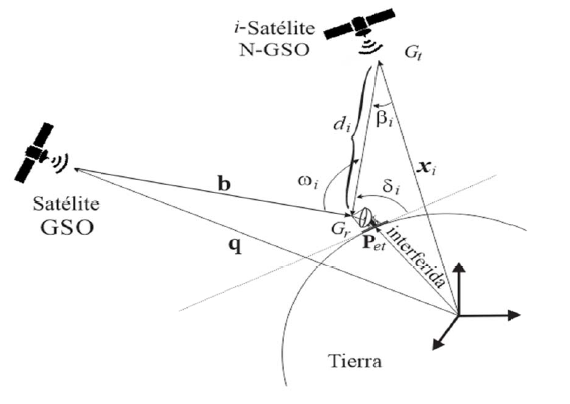Protection of earth stations of the fixed-satellite service in North-American
Main Article Content
Abstract
This work presents a mathematical model for determining a limiting mask for equivalent power flux density produced by the North American region's downlinks of non-GSO satellite systems. This mask protects earth stations from the interference generated by non-GSO satellites. The mathematical model is employed to generate an EPFD↓ mask. An analysis of two systems is made to compare the behavior of the mask in the North American region.
Article Details

This work is licensed under a Creative Commons Attribution 4.0 International License.
Authors who publish in this journal agree to the following terms: Authors retain the copyright and guarantee the journal the right to be the first publication of the work, as well as, licensed under a Creative Commons Attribution License that allows others share the work with an acknowledgment of the authorship of the work and the initial publication in this journal. Authors may separately establish additional agreements for the non-exclusive distribution of the version of the work published in the journal (for example, placing it in an institutional repository or publishing it in a book), with acknowledgment of its initial publication in this journal. Authors are allowed and encouraged to disseminate their work electronically (for example, in institutional repositories or on their own website) before and during the submission process, as it may lead to productive exchanges as well as further citation earliest and oldest of published works.
How to Cite
References
[2] ITU, “Continued development of interference criteria and methodologies for fixed-satellite service coordination between feeder links of non-geostationary satellite networks in the mobile-satellite service and geostationary-satellite networks in the fixed-satellite service in the bands 19.3-19.7 GHz and 29.1-29.5 GHz”, en Conf. ITU World Radiocommunication Conference final acts, 1997, pp. 474-476.
[3] Radio Regulations, International Telecommunication Union, Computer simulation of short-term interference between the feeder-links of two Non-GSO MSS networking sharing the 5 and 7 ghz bands. Recomendación ITU-R, Document 4A/11-E, Sep. 1996.
[4] Radio Regulations, Interference between two N-GSO FSS networks. Recomendación ITU-R, Document a4/101-E, Sep. 1996.
[5] Radio Regulations, Simulation of in-line interference between the feeder links of four separate Non-GSO MSS constellation sat 5/7 ghz (leo-c, leo-d, leo-e and leo-f). Recomendación ITU-R, Document 4A/109-E, Sep. 1996.
[6] Radio Regulations, Simulation results on the epfd calculation for N-GSO FSS system operating in the 12 ghz frequency range. Recomendación ITU-R, Document 4A/32-E, Feb. 1998.
[7] Radio Regulations, Working document towards a preliminary draft new recommendation on frequency sharing between the N-GS fixed satellite service N-GSO and the fixed service (FS) in the band 40.5-42.5 ghz. ITU, Document 4A/32-E, Feb. 1998.
[8] UIT, “Studies relating to consideration of allocations in bands around 1.4 GHz for feeder links of the non-geostationary-satellite systems in the mobile-satellite service with service links operating below 1 GHz” en Conf. ITU World Radiocommunication Conference final acts, 2000, pp. 435-437.
[9] R. Pino and J. Fortes. “Proteção de redes do Serviço Fixo por Satélite que utilizam satélites geoestacionário contra a interferência gerada pelos lances de descida de sistemas não geoestacionários operando na faixa 3,7-4,2 GHz”, tesis de maestría, PUC-Rio, Brasil, Apr. 2018.
[10] JG. Walker. “Circular Orbit Patterns Providing Continuous Whole Earth Coverage”, Royal Aircraft Establishment. Technical report, Tech. Rep. 70211 (UDC 629.195: 521.6), 1970.
[11] J. Forte, R. Sampaio-Neto and J.E Amadores-Maldonado, “Analytical method for assessing interference in interference environments involving NGSO satellite networks”, International journal of satellite communications 17.6. pp 399-419. (1999).
[12] Radio Regulations, Maximum permissible levels of interference in a satellite network (GSO/FSS; non-GSO/FSS; non-GSO/MSS feeder links) for a hypothetical reference digital path in the fixed-satellite service caused by other codirectional FSS networks below 30 GHz, Recommendation ITU-R S. 1323, 1997.
[13] J. Fortes and A. Batista, “Satellite link performance under rain and external interferences: Constraints to be imposed on the statistical behavior of the external interferences”. International Journal of Satellite Communications and networking, 2010.
[14] Radio Regulations, Satellite antenna radiation pattern for use as a design objective in the fixed-satellite service employing geostationary satellite, Recommendation ITU-R S.672-4, 1997.

